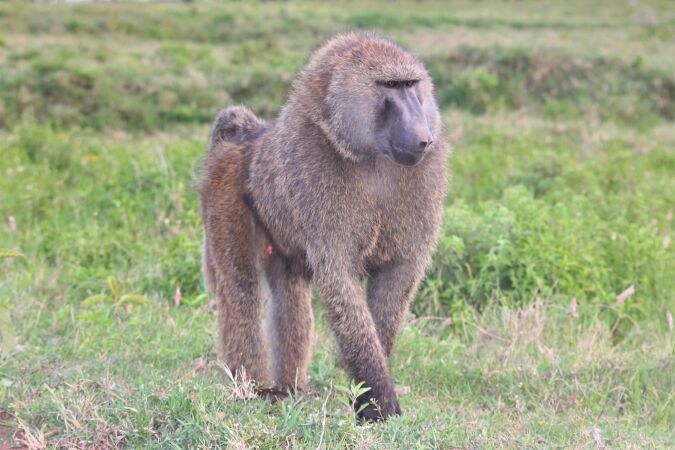

The Olive baboon (Papio anubis), also known as the Anubis baboon, is part of the Old-World Monkeys, a species of the most wide-ranging baboons worldwide. Widely found in sub-Saharan Africa, these baboons inhabit savanna, moist, evergreen forests, rocky cliffs, dry woodland, open grassland, and deserts.
These primates are more active during the day and spend most of it foraging for food. They are omnivorous, enjoying a varied diet that includes grass and seeds, roots, birds, fruit, leaves, bark, eggs, frogs, fish, insects, and even young mammals.
Baboons are quite vocal and use many vocalizations to communicate within the troop. Mating occurs throughout the year, with a gestation period of around 187 days after which one infant is born, which will be weaned by 8 months old.
Olive baboons live in troops of between 20 to 100 individuals and are quite social.
Predators of the Olive baboon include lions, leopards, hyenas, wild dogs, and crocodiles. Unfortunately, as society develops and encroaches on previous wilderness areas, conflict situations with humans are more apparent. These baboons are also hunted for both food and sport.
Their conservation status is listed as “least concern” by the IUCN.
Name:
Papio Anubis
Male Weight:
53-82 pounds
Shoulder height:
23-27 inches
Range:
Sub-Saharan Africa
Gestation Period:
187 days
Life span:
25 years
When Olive baboon hunting in Africa, look for an animal walking on all fours at times, with a dog-like muzzle, powerful jaws, and long, pointed canine teeth. Its tail looks almost broken near the base and is about 14-22 inches long.
The Olive baboon is named after its coat which, from a distance, looks like a gray-green color with fur of yellow-brown and black bands. Up close, it is evident that the fur is actually multi-colored. The face is dark gray to black and furless, with coarse, short hair around the muzzle and large amber-colored eyes. The males of the species have longer fur than their female counterparts.
Males are larger than females and can be up to twice their size, weighing in at around 53-82 pounds versus 32-34 pounds of their female counterparts.
An interesting fact about this baboon is the cheek pouches in which it stores food.
When Olive baboon hunting in Africa, the spot-and-stalk method is often utilized on this hunting safari, but great care must be taken not to underestimate this intelligent primate. Baboons are exceptionally clever and evasive. The ambush method is often used when targeting troops that are attacking agricultural fields and crops.
These baboons live in large troops, ensuring plenty of eyes and ears on the lookout for danger, so take it slow and easy when approaching them on this game hunting adventure. Their sharp senses of sight and hearing allow them to quickly react to any perceived danger by heading to cliffs and trees out of the way. At a top speed of 25mph, they can also outrun some predators.
For hunters on an Olive baboon hunting safari, the reward lies in harvesting this outsmarting this intelligent creature, with a great trophy to add to their game hunting collection.
The best rifle is a small to medium caliber rifle fitted, with a good scope. Anything from a .270 to a .375 will work well on this hunting safari. They are often opportunistic prey, with shots taken over long distances. A 300 win-mag is also an excellent choice for the longer shots loaded with a minimum of 165 grain.
Search from our range of Hunts across various popular destinations in Africa.
Find A Hunt